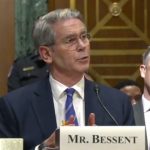Alex Wong/Getty Images
- A congresswoman and former defense secretary recently argued the US needs a “no first use” policy for nukes.
- Trump’s presidency shows the risks of giving a president total control over the nuclear arsenal, they said.
- Nuclear experts say the US should change the status quo, but military leaders disagree.
- Visit the Business section of Insider for more stories.
Donald Trump is out of the White House and away from the nukes, but the volatility of his presidency has once again raised questions about whether any commander in chief should have sole and unchecked authority over the US nuclear arsenal.
In late January, just a few days after President Joe Biden took office, Massachusetts Sen. Elizabeth Warren and former Secretary of Defense William Perry wrote that “no president should have unilateral power to use nuclear weapons” in an op-ed published by USA Today.
The article pointed to the deadly Capitol riots Trump was impeached for inciting and noted that for two weeks after that incident, he maintained control of one of the world’s largest nuclear arsenals.
When Trump, a twice impeached president, departed the White House on the morning of Biden’s inauguration, he was followed by a military aide carrying the “nuclear football.” Though his presidency was basically already over, Trump still had the authority to order a nuclear strike for a few more hours.
“Having the president have sole authority to order a nuclear strike is just outrageous, to have that power in one person’s hands. It does not matter who that one person is,” Jessica Sleight, a program director at Global Zero, an advocacy organization working toward the total elimination of nuclear weapons, told Insider. “It is outdated, it’s unnecessary, and it’s dangerous.”
“People really paid attention to this issue under the former administration just because of how volatile it was, but to me, Trump was really just a highlighter for how broken the process itself is,” she said.
‘Worst case scenario’
Chip Somodevilla/Getty Images
If a president decided to use nuclear weapons, the “nuclear football” would be opened, and the president would be presented with pre-approved strike options. The commander in chief may choose to consult with senior advisors and military leaders before proceeding, but that is not a requirement.
Using the “biscuit,” a coded card that the president carries on his person, he would identify himself to a military official in the National Military Command Center, who would then receive and transmit strike orders once it was clear the orders were coming from the president.
Within just a few minutes, nuclear weapons aboard strategic bombers or carried by land-based or submarine-launched missiles would be in the air. Officials in the chain of command can theoretically object or resign in protest, but it is ultimately the Pentagon’s job to carry out any legal order from the president.
The president’s unchecked power to start a nuclear war dates back to Harry Truman, the only president to ever permit the use of nuclear force against an adversary.
While this concept was informally established during the final weeks of World War II, it was not until the Korean War that Truman’s White House officially asserted that “only the President can authorize the use of the atom bomb.”
Amid Cold War tensions with a nuclear-armed Soviet Union, the need for an immediate nuclear response, one that could be executed in minutes to prevent an enemy from crippling the US nuclear arsenal with a surprise attack, became a priority.
That fear of a surprise attack gave birth to the “nuclear football,” which was created to ensure that the president could wage a nuclear war at any time, no matter where he was.
The Cold War ended more than thirty years ago, but many of the same concerns continue to drive US nuclear authority and posturing decisions today.
“The entire premise of ‘the football’ is that the president must be able to order the launch of hundreds of nuclear weapons in a few minutes in the event of a surprise attack by Russia,” Jeffrey Lewis, a nuclear weapons and non-proliferation expert at the Middlebury Institute of International Studies, told Insider.
“The entire command and control system is warped to deal with this unlikely event,” he said.
“When it comes to war planning, the people in charge always envision the worst case scenario,” Stephen Schwartz, a non-resident senior fellow at the Bulletin of the Atomic Scientists, told Insider. “That’s why our nuclear weapons are still kept on alert, and that’s why the president is still followed around by the football.”
‘Tremendous danger’
Photo by Olivier Doulier – Pool/Getty Images
Presidential control of the nuclear arsenal, which rests on the competencies and capabilities of one man, has not always gone off without a hitch.
During Gerald Ford’s presidency, the “nuclear football” was accidentally left aboard Air Force One. Presidents Ronald Reagan, George H.W. Bush, and Bill Clinton are also said to have gotten separated from the aide carrying the briefcase at one point or another.
Jimmy Carter sent a suit out to the dry cleaner with his “biscuit” inside, a former military aide says Clinton lost his card, and the FBI took possession of Reagan’s card after agents took his clothes at the hospital following the attempt on his life.
None of these incidents “tremendously imperiled presidential command and control,” Schwartz told Insider, “but they do point out the fact that when you have one person in charge of all this, it does put a premium on everything working and nothing going wrong.”
More concerning are the times when serious questions have been raised about the president’s mental health.
Facing impeachment, a seemingly depressed Richard Nixon who was drinking heavily sparked fears among members of his own Cabinet and some in Congress that he might order a nuclear strike and kill millions. Some similar concerns were raised about Trump after the Capitol riots.
As Schwartz explained, the president is the only person in the nuclear chain of command that does not have to pass or be a part of the US military’s personnel reliability program. Presidents are given authority over the nuclear arsenal simply because they are the president.
The greatest concern, though, is that a president might make the wrong call in a tense situation with no one in a position to stop it.
There is a fear, Hans Kristensen, a nuclear expert with the Federation of American Scientists, told Insider, that a “president that was a little unhinged would reach for that ‘nuclear sword’ sooner than he really should.”
During the Cold War, there were a number of nuclear close calls on both sides that fortunately did not escalate, such as the 1979 North American Aerospace Defense Command computer glitch that suggested a Soviet nuclear strike was underway. The US readied its systems and weapons in response, and the world came dangerously close to nuclear war.
It was determined to be a false alarm before the president was called, but the big question remains, if it had reached the president, would he have made the right decision?
Soviet leader Leonid Brezhnev wrote to Jimmy Carter in the aftermath, calling the incident “fraught with a tremendous danger.”
“The most urgent task is not to make the response capability better,” Kristensen said. “The most urgent task is to reduce the possibility of mistakes and wrong decisions.”
‘No need to panic and launch’
Chip Somodevilla/Getty Images
Sen. Warren previously introduced legislation calling for a “no first use” nuclear posture that would have legally prohibited the president from using nuclear weapons first.
The senator’s recent op-ed took things a step further and threw support to a bill previously introduced by fellow Massachusetts Sen. Ed Markey and California Rep. Ted Lieu that said that the Congress should be involved in any decision to use nuclear weapons given the legislative branch’s constitutional authority to declare war.
Warren is expected to reintroduce her bill, an aide told Insider. It is unclear if the legislation will be changed to include the suggestions of her colleagues in Congress.
An alternative to having lawmakers in the decision-making loop is incorporating the secretary of defense and attorney general into any decision.
None of these proposed ideas have ever really gone anywhere, though. “It’s somewhat Groundhog Day with this discussion because we’ve been here so many times before,” Kristensen told Insider.
“At the end of the day,” he explained, “it has been always the outcome that they die because people say you don’t want to have a situation where you box in the presidential decision-making by making it dependent on someone else.”
There is also an argument that changing the nuclear status quo could weaken US deterrence against rival nuclear powers, but nuclear weapons experts say that does not make sense.
“If you can’t hit first, why would that weaken deterrence?” Kristensen asked.
Sleight argued that “the US has the non-nuclear capabilities to credibly deter a non-nuclear attack against the US and our allies, and US second strike nuclear capability is a credible deterrent against a nuclear attack.”
Making a similar case, Kristensen told Insider that “there’s nothing an adversary, even a Russian-sized adversary, can do that would knock out our ability to retaliate,” so “there is no need to panic and launch.”
Biden has not been vocal about presidential command authority, but he has spoken about “no first use,” which he discussed as vice president.
“Given our non-nuclear capabilities and the nature of today’s threats, it’s hard to envision a plausible scenario in which the first use of nuclear weapons by the United States would be necessary,” he said in early 2017, expressing confidence that “we can deter-and defend ourselves and our Allies against-non-nuclear threats through other means.”
Biden has also said that the sole purpose of the US nuclear arsenal should be retaliating against a nuclear attack, meaning that nuclear weapons would not be used in response to conventional, chemical, biological, or cyber attacks.
US military leaders have repeatedly pushed back against this thinking, stressing that America’s longstanding position of strategic ambiguity about whether it would use nuclear weapons is preferred to any limitations.
“Anything that simplifies an enemy’s decision-making calculus would be a mistake, and that’s exactly what this would do,” Gen. John Hyten, then the head of US Strategic Command, told lawmakers in 2019.
Adm. Charles Richard, who currently heads STRATCOM, stated last year that his “best military advice would be to not adopt a ‘no first use’ policy.”
More recently, Richard told reporters that he would welcome an evaluation of the US nuclear weapons strategy by the new Biden administration, which is expected to conduct its own nuclear posture review.
“I recommend that based on the threat,” he said last month, explaining that the current situation “warrants another look at it to make sure that we still endorse our strategy and we have sufficient capability to execute that strategy.”
Powered by WPeMatico




